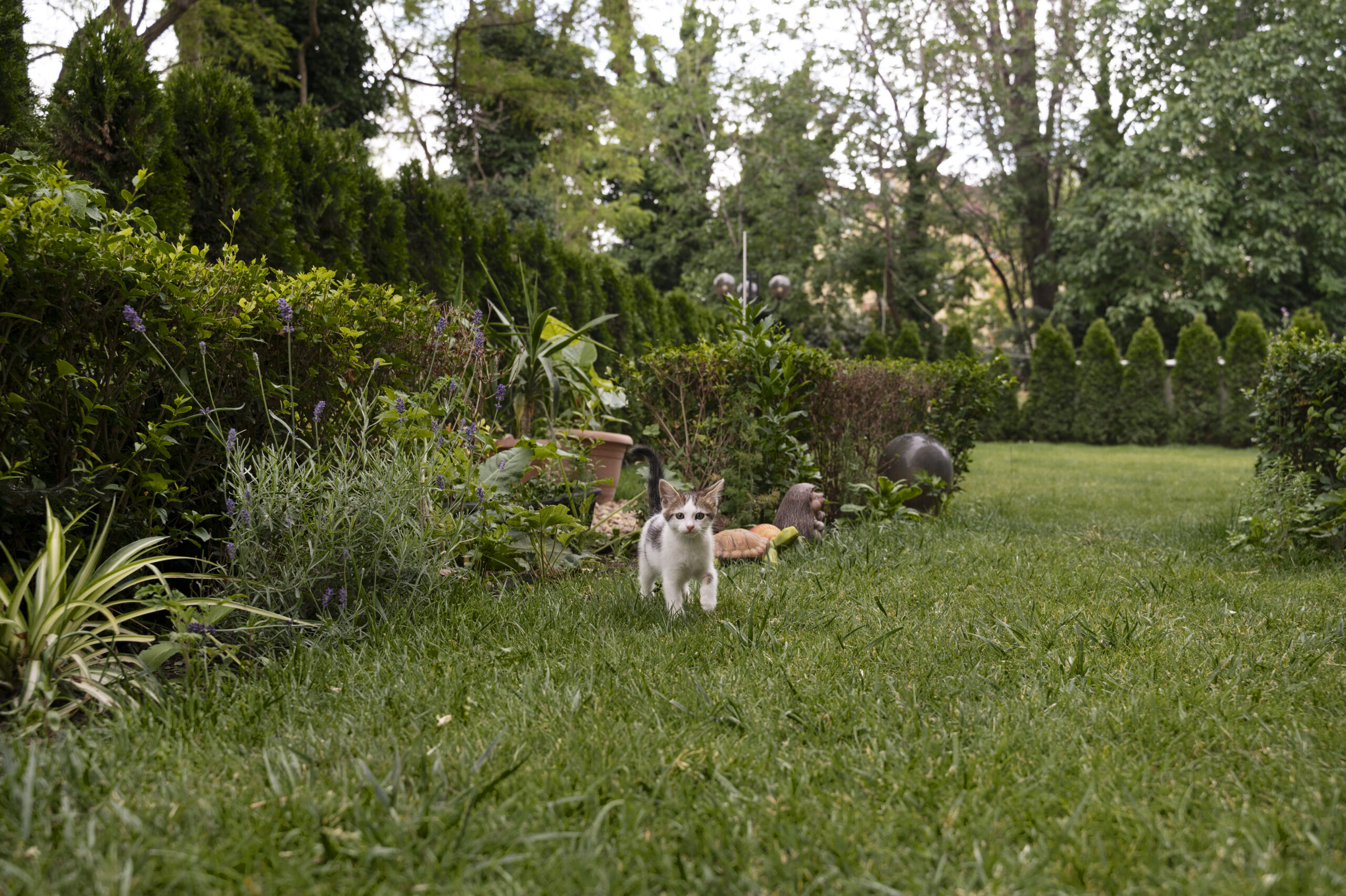how to keep cats out of garden beds naturally
To naturally keep cats out of your garden, disrupt their digging and toileting by covering soil with prickly materials like pine cones, gravel, or chicken wire, or by installing plastic garden spikes.
You can also deter them with strong scents from citrus peels, coffee grounds, vinegar, or cat-repelling plants such as lavender or pennyroyal.
To make your garden less appealing, plant densely, keep bird feeders off the ground, and maintain secure bins to prevent the scent of food from attracting them.
Table of Contents
ToggleUnderstanding Cat Behavior
Before you can keep cats out of your garden, it helps to understand why they are drawn there in the first place. A garden bed, especially one freshly turned or mulched, looks like the perfect spot to a cat.
The loose soil makes it easy for them to dig, and the quiet, sheltered corners offer safety from larger animals. What seems like destructive behavior to us often comes from very natural feline instincts.
Soft soil as a litter box
Cats prefer soft, easy-to-dig soil for their bathroom needs. Your raised beds or freshly tilled plots mimic the conditions they seek out. It is not that they are targeting your plants on purpose; the soil texture itself attracts them.
Understanding this makes it clear why physical barriers and soil surface changes often work best.
Territorial marking and scent
Cats are territorial creatures. They use scent glands in their paws and face to mark areas as their own. When they scratch or dig in your garden bed, they are not only exploring but also leaving behind a scent signal.
Droppings also serve as a strong marker, warning other cats to stay away. Unfortunately, this can mean one neighborhood cat uses your bed repeatedly, making the problem worse.
Hunting instincts
Gardens attract birds, small rodents, and insects. To a cat, this looks like a hunting ground. They may crouch among the plants waiting for prey or dig around in search of movement under the soil. Even well-fed domestic cats retain these instincts, and gardens provide a natural setting for them to practice.
Comfort and shelter
Raised beds, mulch piles, and dense plantings create shaded, warm, or sheltered spots. Cats may curl up in the middle of your flowers for a nap or choose a row of vegetables as a hiding place. While harmless to them, this often damages seedlings and compacts soil where plants need to breathe.
By recognizing these behaviors, you can better choose humane deterrents. The goal is not to punish the cat but to make your garden less attractive. Strategies like covering the soil, adding scents cats dislike, or providing alternate spaces nearby become more effective when you work with, rather than against, natural feline tendencies
3. Physical Barriers
One of the most reliable ways to keep cats out of your garden beds is to block access altogether. Cats are persistent, but they will usually give up if an area feels uncomfortable or difficult to reach.
Garden fencing
A short wire fence, chicken wire, or even decorative metal edging can prevent cats from wandering into your beds. Cats dislike climbing over unstable surfaces, so even a low barrier can be enough.
Raised bed covers
Mesh covers, cages, or cloches placed directly over your garden beds work especially well for protecting young seedlings. These structures not only deter cats but also shield plants from birds and other pests.
Mulching with rough textures
Cats prefer soft soil under their paws, so switching to rough mulch makes your beds less appealing. Pine cones, coarse bark, or even small stones disrupt the digging surface and encourage cats to move on.
Motion-activated sprinklers
Water is an excellent deterrent. Motion-activated sprinklers startle cats without harming them, creating a strong association that the garden is not a safe spot. These also help deter raccoons, rabbits, and other unwanted visitors.
4. Scent-Based Deterrents
Cats rely heavily on scent to decide where they feel comfortable. Strong, unpleasant smells can discourage them from returning to your garden beds.
Citrus peels or sprays
Cats strongly dislike citrus. Scattering orange, lemon, or grapefruit peels around your plants creates a natural boundary. Citrus-based sprays work the same way and need reapplying after rain.
Vinegar spray
A diluted vinegar solution misted on garden edges or fence posts adds a sharp odor that most cats avoid. Avoid spraying directly on plants, as vinegar can harm foliage.
Coffee grounds and herbs
Used coffee grounds, lavender, rosemary, and rue are natural deterrents. Spread them around garden borders or mix them lightly into mulch. The bonus is that coffee grounds also enrich your soil.
Commercial repellents
If home remedies are not enough, pet-safe commercial cat repellent sprays or granules are widely available. These products are designed to last longer outdoors and can cover larger areas effectively.
Scent-based methods are most effective when combined with barriers or alternative spaces for cats. By working with their sensitive noses, you guide them away without hare
5. Plant-Based Repellents
Certain plants act as natural deterrents to cats because of their strong scent or texture. Adding these to your garden design can keep cats from wandering into sensitive beds while still enhancing your garden’s overall look.
Cat-repelling plants
Coleus canina, often called the “scaredy-cat plant,” gives off a strong odor that cats dislike. Lavender and rue also make good choices. They not only deter cats but also attract pollinators like bees and butterflies.
Aromatic herbs
Strong-smelling herbs such as rosemary and pennyroyal serve a dual purpose. They add fragrance to your garden and work as natural barriers. Cats tend to avoid these plants, especially if they are planted along the edges of beds or pathways.
By weaving these deterrent plants into your layout, you can create a protective border while still keeping your garden visually appealing and productive.
6. Noise and Motion Deterrents
Cats are alert animals that dislike sudden noises or unexpected movement. Using this trait can help you keep them away from your plants.
Ultrasonic cat repellents
These devices emit a sound at a frequency only animals can hear. Placed strategically around garden beds, they activate when motion is detected, startling cats without harming them.
Wind chimes or noisy objects
Simple additions like wind chimes, aluminum foil strips, or even empty cans tied together can create unpredictable noises. Cats usually prefer quiet, stable environments, so these sounds encourage them to avoid the area.
Moving decoys
Plastic owls, hawk figures, or even spinning pinwheels tap into a cat’s instinctive caution around predators. To stay effective, rotate or move these decoys often so cats do not get used to them.
This combination of noise and motion creates an unpredictable environment that most cats will choose to avoid.
7. Alternative Solutions
Sometimes the best way to protect your main garden beds is to redirect cats to a more appealing space of their own. By giving them an alternative, you reduce their interest in your vegetables and flowers.
Decoy zone
A small sandpit or a designated bare-soil corner can satisfy a cat’s natural digging and bathroom habits. This keeps them occupied without disturbing your crops.
Planting catnip away from the garden
Cats love catnip, so planting it in a separate spot draws them away from your beds. This works especially well if you pair it with fencing or deterrents around your main garden.
Outdoor litter boxes
Covered litter boxes placed discreetly in the yard give cats a proper outlet. This solution works well if you own the cats or want to keep neighborhood pets from choosing your garden as their restroom.
By offering safe alternatives, you reduce conflict and keep both your plants and the local cats happy.
8. Maintenance and Monitoring
Deterring cats from garden beds is not a one-time effort. To keep your strategies effective, you need to maintain and adjust them as the seasons progress. Cats are intelligent and adaptable, so a method that works today might lose its impact if it becomes too familiar.
Refreshing scents regularly
Scent-based repellents such as citrus peels, vinegar sprays, or coffee grounds fade over time due to rain, wind, or sun exposure.
Reapplying them once or twice a week ensures they remain strong enough to deter cats. If you use commercial repellents, follow the label instructions for safe and effective reapplication.
Moving deterrents around
Cats quickly learn when an object or noise is harmless. By changing the position of motion-activated sprinklers, wind chimes, or decoys, you prevent them from becoming part of the background. This keeps the element of surprise alive, which is key to discouraging unwanted visits.
Checking for gaps in barriers
Physical defenses like fences, mesh covers, or raised bed cages work only when they are intact. Regularly walk around your garden and inspect for loose edges, gaps, or weak spots where cats could slip through. Repairing or reinforcing these areas will keep your protective setup strong.
In my own experience, consistency makes the biggest difference. When I kept up with spraying scents after rain and shifted deterrents every couple of weeks, the neighborhood cats lost interest in my garden entirely. Treat this process like routine garden care, and your plants will thrive without disturbance.
Maintenance and Monitoring for Effective Cat Deterrence
From my experience, keeping your garden protected from cats is not a one-time setup. I learned that regular attention makes all the difference.
Refresh Scents Regularly
Scent-based deterrents lose potency over time. I spray my rosemary and rue-based repellents every few days. This constant refresh keeps cats cautious and prevents them from returning.
Move Deterrents Around
Cats are clever. If you leave decoys, motion alarms, or noisy objects in the same spot, they quickly learn to ignore them. I rotate my owl decoy and move wind chimes every week. This keeps the garden unpredictable and effective.
Check for Gaps
Even a tiny gap in a fence or cover can give a cat easy access. I walk my garden weekly to inspect for openings and repair them immediately. This simple habit has prevented repeated intrusions.
By consistently refreshing scents, rotating deterrents, and checking barriers, I keep my garden safe while letting plants thrive.
Conclusion
From my experience, the most effective way to keep cats out of your garden is to focus on humane and safe strategies. Chemical-free scents, motion-based deterrents, and physical barriers all protect your plants without harming animals.
I found that combining multiple methods consistently produces the best results, as cats are less likely to adapt when they face a variety of deterrents.
Gardening is personal, and every space is unique. I encourage experimenting with different solutions, observing what works, and adjusting your approach until you find the right balance for your garden.
Sharing tips and experiences with fellow gardeners can also inspire new ideas and strategies, so don’t hesitate to connect and discuss what has worked for you.






